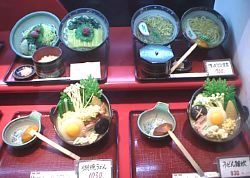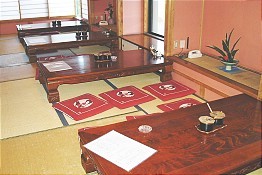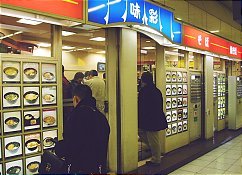| basic information |
Entering the Restaurant
Many restaurants in Japan display plastic or wax replicas of their dishes at the entrance. These replicas serve both to entice and inform patrons and can be especially helpful for foreign tourists who do not speak Japanese. These displays offer a very accurate, visual description of the style and price of meals found inside.

Upon entering a restaurant, customers are greeted with the expression "irasshaimase" meaning "please come in", or "welcome". Waiters and waitresses are trained to be very efficient, polite and attentive, and will usually immediately lead you to your table. If they don't, you can assume that it is okay to sit at any table.
While a majority of restaurants in Japan are equipped exclusively with Western style tables and chairs, restaurants with low traditional tables are also common. Some restaurants feature both styles side by side. In traditions Japanese interiors, you are usually required to take off your shoes at the restaurant's entrance, or before stepping onto the seating area.


Eating
After you sit down, a glass of water or tea will be served for free and later refilled. You also receive a wet towel (oshibori) for cleaning your hands. If chopsticks are not already set, you can usually find some in a box on the table. Most often, they are wooden chopsticks that need to be separated into two before usage.
At some restaurant, such as izakaya, it is common for everyone in the party to order and share various dishes. At restaurants that serve set menus, bowl dishes (such as domburi or noodle soups) or Western style dishes, each person usually orders and eats their own meal.
Paying
The bill will be presented upside down, either as you receive the meal, or after you finish eating. In most restaurants, you are supposed to bring your bill to the cashier near the exit when leaving. Some restaurants, especially cheaper ones, have slightly different systems for ordering and paying.
For example, in many ramen and gyudon restaurants, "meal tickets" are bought at a vending machine near the store's entrance and handed over to the staff who then prepare and serve the meal.
Tipping in Japan is not common or expected and the staff may chase you out of the restaurant in order to give back any money left behind. Instead, it is polite to say "gochisosama deshita" ("thank you for the meal") when leaving.

No comments:
Post a Comment